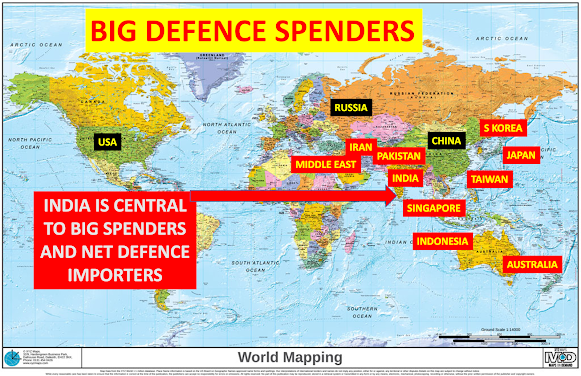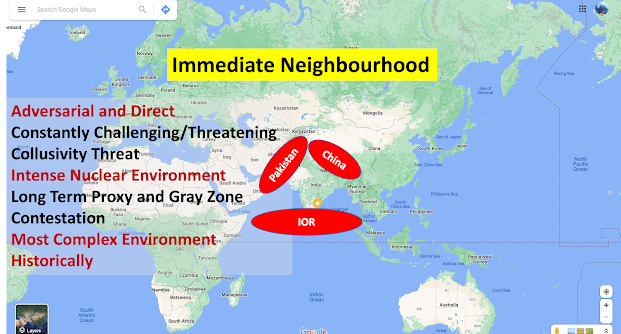India is a civilisational power with deep rooted cultural values. It sits at the crossroads of global maritime flows due to its dominant location in the Indian Ocean Region (IOR). Resultantly India has always lived in a very complex and challenging strategic environment. In modern times, the complexity is driven by many factors. These include global trends, India’s national interests and the geopolitical equations India maintains with its neighbourhood and the world at large and the constant debate whether to adopt a continental or maritime strategy. It is interesting just to define the challenging environment even before attempting to find answers to navigate the strategic complexities.
Global Trends
The shift in global power from West to East is now an apparent reality and is no more a trend. Economic power has shifted East. Diplomatic power is shifting and military power will soon follow. As the global population keeps increasing, demographic changes are taking place at a very fast clip all over the world due to migration and varying birth rates. This has constantly given rise to new geostrategic challenges. Growth has also given rise to rapid urbanisation which in turn creates social tension and conflicts. India is at the centre of these major populations where these shifts are happening. A demographic change-conflict cycle is on the cards specially in the densely populated South and East Asia regions which directly affects the Indian geostrategic outlook.
A large part of the changing trend is the rise of disruptive technologies which are shaping geostrategic outlooks of all countries. Last but not the least, climate change and resource scarcity give a whole new dimension to geostrategic outlooks of nations. India is at the centre of these trend lines. A look at the Conflict Zones of this century in West Asia, Middle East, South Asia, Africa and the Indo Pacific region indicates the geostrategic complexity in which India exists. The challenge is acute since each conflict is the result of a different geopolitical phenomenon. There is a discernible shift from the conventional warfare of the last century to the hybrid and humanised conflicts of this century in the Gray Zone. Due to the fact major conflict zones are in our vicinity, the big defence spenders also in the region. This factor also contributes to complicating our strategic environment.

An analysis of disaster zones indicates that the bulk of the major earthquakes and floods have happened in and around Asia with India as the geographic centre. Very importantly, these disasters have occurred at a rate greater than those at which conflicts have taken place and with far greater devastation. Many geopolitical trends and alignments are the resultant of these disasters. The 2004 Tsunami gave rise to the QUAD. The pandemic which originated in Wuhan in 2019 has not yet completed its strategic impact.

National Interests
India’s national interests shape our geostrategic outlook. These have a profound impact on the environment around us. While India’s national interests are not laid down formally, they are enshrined in our constitution. These include protection of land borders, coastline, island territories and sea lanes from external aggression from land, sea and air. This implies that we to have guard our territorial integrity and sovereignty from our traditional adversaries ie China and Pakistan and unknown adversaries who might manifest themselves through the IOR. India must also protect its maritime national interests in the IOR which extends from the Gulf of Aden to the Malacca straits.

Beyond that India has to protect its people internally and the constitution against manifold anti national forces , elements and trends which includes terrorism, extremism, insurgency and militancy.

India has always successfully protected Indians in ‘out of areas’ during contingencies. This includes evacuation of stranded people from troubled areas/ conflict zones like it happened in Kuwait and Yemen, and during natural disasters like it happened from Wuhan during the pandemic.

Geopolitical Equations
Having seen how global trends and national interests impact India’s complex geostrategic environment, this entire phenomenon is better understood in terms of Chanakya’s ‘Mandala’ theory. If we apply Chanakya’s principle, there is a need to consider our geopolitical equations in the immediate, near, intermediate neighbourhoods. These have to be extrapolated with the strategic relationships India has developed beyond its neighbourhoods. However at the core one has to examine the internal issues which drive the complex strategic environment in which India exists.
India’s immediate neighbourhood consists of Pakistan, China and the IOR. The equation with Pakistan and China, both revisionist, has been directly adversarial since independence. Pakistan which is economically defunct and fully radicalised is going through turbulent times. China which till recently was seen to be rising is suffering from wobbles emanating from a slowing economy, a declining population and a revisionist leader aspiring for a lifetime in power. Notwithstanding their internal issues both are overmilitarized and pose a constant threat/challenge to India in a collusive manner. The immediate neighbourhood is also characterised by an intense nuclear environment. China and Pakistan pose a long term proxy / hybrid / gray zone multidimensional threat to India. Historically this is the most complex strategic situation even in global parlance.
India’s near neighbourhood comprises of Afghanistan, Nepal, Bhutan, Myanmar, Sri Lanka and Maldives. These nations have been prone to turmoil internally and externally. Currently, Afghanistan, Myanmar and Sri Lanka are particularly going through tough times. India’s relationship with them has been episodic due to many factors. It has been the constant endeavour of these nations to hedge their bets in finding a strategic alternate to India. Pakistan has been a spoiler in India’s relations with these countries. China has made major inroads into these nations with its BRI projects and endeavours to trap them into eternal debt. Further, an indirect Chinese threat is always on the cards through these countries. Such a threat can bypass or turn our flanks to present a dangerous situation to India. India will always have a challenge to keep these nations on its side with which it has deep ethnic and cultural connections.

India’s intermediate neighbourhood consists of Africa, Middle East, Central Asia, ASEAN, South Korea, Japan and Australia. India’s equations with these nations has been largely cooperative based on historical linkages . However from time to time it has had to endure competition from other countries, especially China. An energy deficient India has deep energy and trade links with these nations. Many countries in the intermediate neighbourhood are part of ongoing conflicts either due to intra-regional dynamics or due to external influences. These countries have also been battle grounds for big power contestations.

Beyond the Intermediate Neighbourhood, India has strategic relationships with USA, Russia, France, EU nations and Israel. The equation with these nations has been one of interdependency. India has also developed deep political linkages with these nations based on historical, democratic, cultural and other perspectives. This is a landscape of changing power equations. It is in this context that one has to consider QUAD in this zone since it is for the first time that India has entered a strategic grouping of such nature. Most importantly, India’s strong strategic relationships have also contributed to loss of its strategic autonomy to a great extent. As India continues to rise, these strategic relationships will have a bearing on India’s geopolitical heft.

India has many internal issues which complicate its external strategic environment. These are largely well known but are worth recounting. India remains energy deficient, disaster prone and susceptible to climate change adversely. Historically India has been dependant on outside powers and has rarely been able to attain strategic autonomy. It suffers from partisan politics which has not been able to rise to the occasion on issues of national importance. Its governance lacks a strategic culture. India has also shown tendencies to veer towards self-inflicted ethnic and religious fractures. It has been subject to a long running proxy war in J&K and the insurgencies in the NE have had an extended lease of life due to instabilities in Bangladesh and Myanmar – past and present. India is yet to develop a defence industrial base and has not been able to fund its military adequately nor has been able to build adequate capacities to make its defence forces very strong. Despite , all its shortcomings , India remains one of the fastest growing economies globally and has shown great strength during the pandemic to bounce back from adversity. It has great innate strength being the largest democracy. Most importantly it has a professional military force which has gained international respect through its vast experience and in ground performance.

Continental Vs Maritime Debate
In India, there is a constant debate as to what should be our focus - Continental or Maritime? This debate stems from its complex strategic environment. It needs a balanced understanding and approach. India shares land borders of nearly 3500 km with China and over 3000 km with Pakistan which are largely disputed and partly occupied illegally. India has had to defend itself repeatedly against their aggression, assertion and coersion. They constantly pose individual and collusive threats - conventional and unconventional. Both adversaries possess nuclear arsenals which can target the entire Indian landmass. Any weakening on land borders means high likelihood of loss of territorial integrity and an unacceptable threat to our people. Overall the continental threat from Pakistan and China is of highest priority to our sovereignty and security at present. This is compounded by the emerging situation in Afghanistan and the Central Asian Republics. Presently, India has no choice but to prioritise its continental domain in the near future. However it does not mean the maritime domain can be neglected. If India is to grow as a regional or global power, it must dominate the seas and protect its island territories. India must be the maritime policeman in its seas of interest - Bay of Bengal, Arabian Sea and part of Indian Ocean which extends from the Persian Gulf to the Malacca Straits. India must build capacities and develop strategies to make the IOR its fortress. To that end, India must get hold of its neighbourhood – Bangladesh, Myanmar, Sri Lanka, and Maldives. It must do whatever it takes to deny China from developing bases in these countries. Indian Navy must also be enabled to deny the IOR to China or any other adversary when needed. India needs to build for the future. From all perspectives, India’s strategic environment guides it to prioritise the present but simultaneously prepare for the future. India needs a balanced approach.
Poser
Often the question arises - are the Indian Armed Forces modern and strong enough to defend India in this complex strategic environment? The answer is yes. This was clearly visible in Doklam and in Eastern Ladakh where China baulked at conflict escalation. Further our prowess in space technology, nuclear capability, missile technology , ship building capability, gun manufacturing capacity and aircraft technology butters this fact. The next question is then - are the Indian Armed Forces modern enough for a regional power which is destined to be the third largest economy? The answer is no, not yet. At present, India’s force structure is designed to combat the threat it faces. As India grows to be a regional power, it must gravitate to be a capability based force to combat any threat anywhere in the region. It must also shift focus to be a sea power , fill in gaps in its defence capacities and attune itself to the oncoming disruption in military affairs. The challenge before India is to overcome its internal issues and play to its strengths to rise and perform to its potential. The opportunity is there despite the complex strategic environment of India.









A fantastic analysis, covering almost all the aspects of our internal as well as external security. Complements to you Sir for such an enthralling narrative.
ReplyDeleteThis comment has been removed by a blog administrator.
ReplyDelete